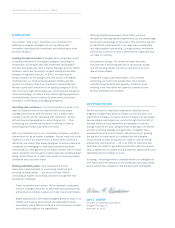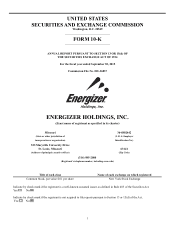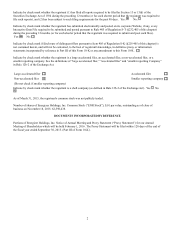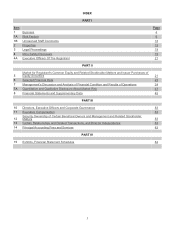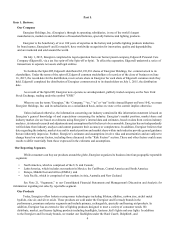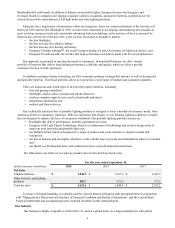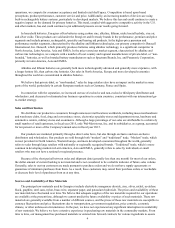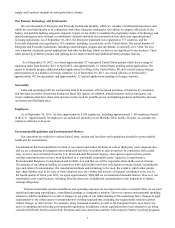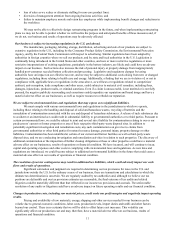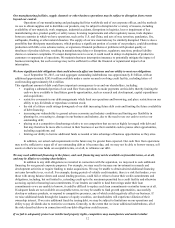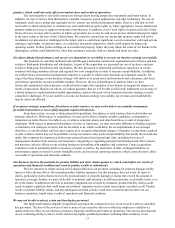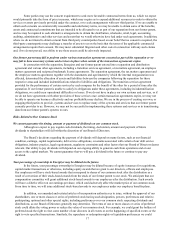Energizer 2015 Annual Report Download - page 14
Download and view the complete annual report
Please find page 14 of the 2015 Energizer annual report below. You can navigate through the pages in the report by either clicking on the pages listed below, or by using the keyword search tool below to find specific information within the annual report.10
relating to internal and external communications, ordering and managing materials from suppliers, converting materials to
finished products, shipping products to customers, processing transactions, summarizing and reporting results of
operations, and complying with regulatory, legal or tax requirements. These information technology systems could be
damaged or cease to function properly due to the poor performance or failure of third party service providers, catastrophic
events, power outages, security breaches, network outages, failed upgrades or other similar events. If our business
continuity plans do not effectively resolve such issues on a timely basis, we may suffer interruptions in conducting our
business, which may adversely impact our operating results. In addition, we recently undertook a significant amount of
work to transform our information technology systems globally to facilitate our spin-off. As such, we face a heightened risk
of system interruptions and deficiencies or failures in our internal controls involving our information systems and
processes.
Our operations depend on the use of information technology systems that are subject to data privacy regulations and could
be the target of cyberattack.
Our systems and networks, as well as those of our retailer customers, suppliers, service providers, and banks, have
and may in the future become the target of cyberattacks or information security breaches, which in turn could result in the
unauthorized release and misuse of confidential or proprietary information about our company, employees, customers or
consumers, as well as disrupt our operations or damage our facilities or those of third parties. Additionally, our systems are
subject to regulation to preserve the privacy of certain data held on those systems. As a result, a failure to comply with
applicable regulations or an unauthorized breach or cyberattack could negatively impact our revenues and increase our
operating and capital costs. It could also damage our reputation with retailer customers and consumers and diminish the
strength and reputation of our brands, or require us to pay monetary penalties. We may also be required to incur additional
costs to modify or enhance our systems or in order to try to prevent or remediate any such attacks.
If we cannot continue to develop new products in a timely manner, market them at favorable margins, and maintain
attractive performance standards in our existing products, we may not be able to compete effectively.
The battery and portable lighting products industries have been notable for developments in product life, product
design and applied technology, and our success depends on future innovations by us. The successful development and
introduction of new products requires retail and consumer acceptance and overcoming the reaction from competitors. New
product introductions in categories where we have existing products will likely also reduce the sales of our existing products.
Our investments in research and development may not result in successful products or innovation that will recover the costs
of such investments. Our customers or end consumers may not purchase our new products once introduced. Additionally,
new products could require regulatory approval which may not be available or may require modification to the product
which could impact the production process. Our competitors may introduce new or enhanced products that outperform ours,
or develop manufacturing technology that permits them to manufacture at a lower cost relative to ours and sell at a lower
price. If we fail to develop and launch successful new products or fail to reduce our cost structure to a competitive level, we
may be unable to grow our business and compete successfully.
Our business also depends on our ability to continue to manufacture our existing products to meet the applicable
product performance claims we have made to our customers. Any decline in these standards could result in the loss of
business and negatively impact our performance and financial results. Finally, our ability to maintain favorable margins on
our products requires us to manage our manufacturing and other production costs relative to our prices. We may not be able
to increase our prices in the event that our production costs increase, which would decrease our profit margins and
negatively impact our business and financial results.
We may not be able to achieve cost savings as a result of any current or future restructuring efforts.
To operate more efficiently and control costs, we have entered into, and may seek to enter into additional,
restructuring and cost reduction plans. We may be unable to identify cost savings opportunities to be achieved by such
plans in the future. Our ability to achieve the anticipated cost savings and other benefits from these initiatives within the
expected time frame is subject to many estimates and assumptions and other factors that we may not be able to control. We
may also incur significant charges related to restructuring plans, which would reduce our profitability in the periods such
charges are incurred.
Execution of any restructuring program also presents a number of significant risks, including:
• actual or perceived disruption of service or reduction in service standards to customers;
• the failure to preserve adequate internal controls as we restructure our general and administrative functions,
including our information technology and financial reporting infrastructure;
• the failure to preserve supplier relationships and distribution, sales and other important relationships and to
resolve conflicts that may arise;


